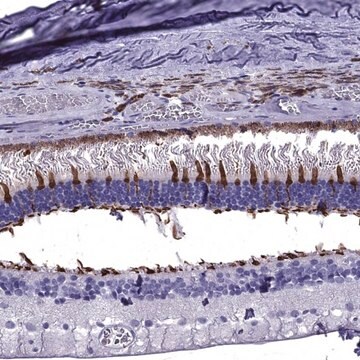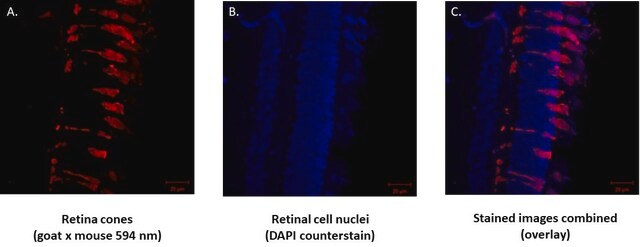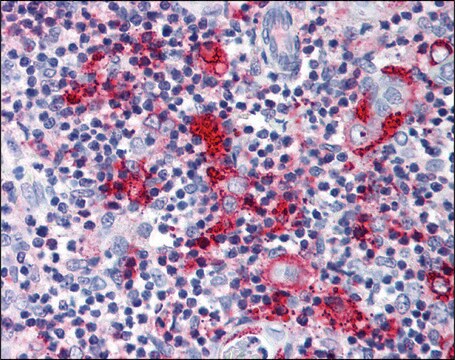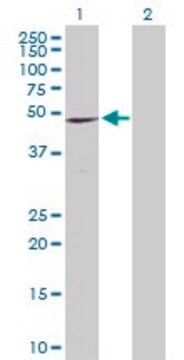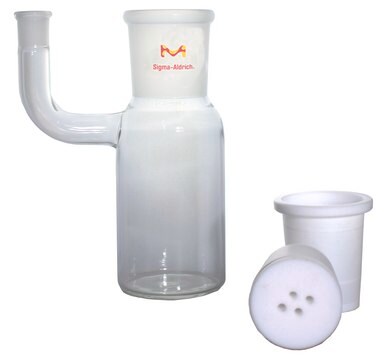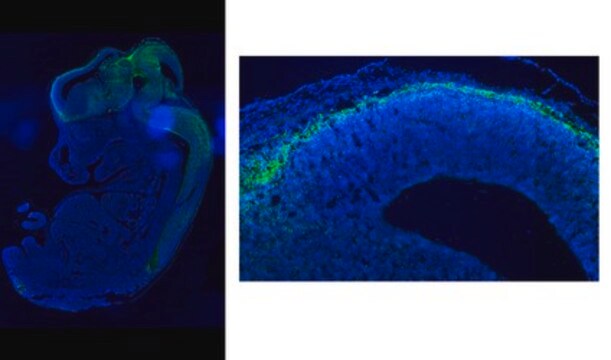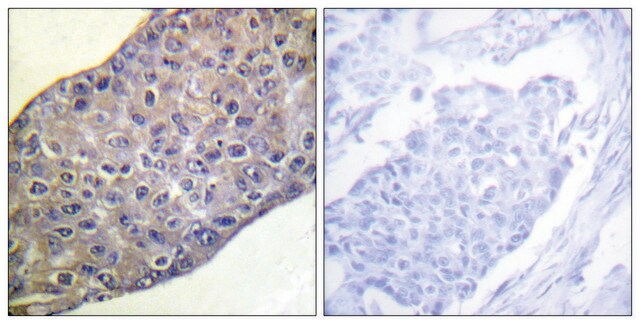推薦產品
生物源
rat
品質等級
共軛
unconjugated
抗體表格
purified antibody
抗體產品種類
primary antibodies
無性繁殖
7E7, monoclonal
分子量
calculated mol wt 41.91 kDa
純化經由
using protein G
物種活性
mouse, human
包裝
antibody small pack of 100 μg
技術
flow cytometry: suitable
immunofluorescence: suitable
immunohistochemistry (formalin-fixed, paraffin-embedded sections): suitable
同型
IgG2b
表位序列
N-terminal
Protein ID登錄號
UniProt登錄號
運輸包裝
ambient
目標翻譯後修改
unmodified
基因資訊
human ... TACSTD2(4070)
一般說明
C-C chemokine receptor type 9 (UniProt: Q9WUT7; also known as C-C CKR-9, CC-CKR-9, CCR-9, Chemokine C-C receptor 10, CDw199) is encoded by the Crr9 (also known as Cmkbr10) gene (Gene ID: 12769) in murine species. CCR9 is a multi-pass membrane protein of the G-protein coupled receptor 1 family. It has four extracellular domains, seven transmembrane domains, and four cytoplasmic domains and serves as a receptor for chemokine CCL25/TECK. It is highly expressed in the thymus tissue. It is also expressed on virtually all small intestinal T cells and IgA-producing plasma cells (PCs) from the spleen. It is reported to be crucial for the positioning of PCs to the small intestine. Higher expression of CCR9 is observed in newly generated PCs and it is down-regulated once these cells reach their final destination in the intestine. In wild-type mice, a majority of the PCs are shown to locate to the lower half of the villus where CCL25 is also expressed at high levels. CCR9 deficient mice exhibit reduced number of PCs in the intestine and are unable to mount a T cell dependent antigen specific IgA response. CCR9-/- hematopoietic stem cells are deficient in their ability to generate all major thymocyte subsets. (Ref.: Svensson, M., et al. (2008). J. Leukoc. Biol. 83(1); 156-164; Pabst, O., et al. (2004). J. Exp. Med. 199(3); 411-416).
特異性
Clone 7E7 is a rat monoclonal antibody that detects C-C chemokine receptor type 9 (CCR9). It targets an epitope within 20 amino acids from the fist extracellular domain in the N-terminal region.
免疫原
KLH-conjugated linear peptide corresponding to 20 amino acids from the first extracellular domain in the N-terminal region of mouse C-C-chemokine receptor type 9 (CCR9).
應用
Quality Control Testing
Evaluated by Flow Cytometry in BALB/c mouse thymocytes.
Flow Cytometry Analysis: 1 μg of this antibody detected CCR9 in one million BALB/c mouse thymocytes.
Tested Applications
Immunohistochemistry Applications: A representative lot detected CCR9 in Immunohistochemistry applications (Guo, Z., et al. (2008). Int Immunol. 20(3):307-15; Pabst, O., et al. (2004). J Exp Med. 199(3):411-6; McGuire, H.M., et al. (2011). Immunity. 34(4):602-15).
Flow Cytometry Analysis: A representative lot detected CCR9 in Flow Cytometry applications (Guo, Z., et al. (2008). Int Immunol. 20(3):307-15; Pabst, O., et al. (2004). J Exp Med. 199(3):411-6; McGuire, H.M., et al. (2011). Immunity. 34(4):602-15; Svensson, M., et al. (2008). J Leukoc Biol. 83(1):156-64; Chennupati, V., et al. (2010). J Immunol. 185(9):5160-8).
Immunofluorescence Analysis: A representative lot detected CCR9 in Immunofluorescence applications (Guo, Z., et al. (2008). Int Immunol. 20(3):307-15; Pabst, O., et al. (2004). J Exp Med. 199(3):411-6; McGuire, H.M., et al. (2011). Immunity. 34(4):602-15).
Note: Actual optimal working dilutions must be determined by end user as specimens, and experimental conditions may vary with the end user
Evaluated by Flow Cytometry in BALB/c mouse thymocytes.
Flow Cytometry Analysis: 1 μg of this antibody detected CCR9 in one million BALB/c mouse thymocytes.
Tested Applications
Immunohistochemistry Applications: A representative lot detected CCR9 in Immunohistochemistry applications (Guo, Z., et al. (2008). Int Immunol. 20(3):307-15; Pabst, O., et al. (2004). J Exp Med. 199(3):411-6; McGuire, H.M., et al. (2011). Immunity. 34(4):602-15).
Flow Cytometry Analysis: A representative lot detected CCR9 in Flow Cytometry applications (Guo, Z., et al. (2008). Int Immunol. 20(3):307-15; Pabst, O., et al. (2004). J Exp Med. 199(3):411-6; McGuire, H.M., et al. (2011). Immunity. 34(4):602-15; Svensson, M., et al. (2008). J Leukoc Biol. 83(1):156-64; Chennupati, V., et al. (2010). J Immunol. 185(9):5160-8).
Immunofluorescence Analysis: A representative lot detected CCR9 in Immunofluorescence applications (Guo, Z., et al. (2008). Int Immunol. 20(3):307-15; Pabst, O., et al. (2004). J Exp Med. 199(3):411-6; McGuire, H.M., et al. (2011). Immunity. 34(4):602-15).
Note: Actual optimal working dilutions must be determined by end user as specimens, and experimental conditions may vary with the end user
Anti-CCR9, clone 7E7, Cat. No. MABF2791, is a rat monoclonal antibody that detects CCR9 and is tested for use in Flow Cytometry, Immunofluorescence, and Immunohistochemistry.
外觀
Purified rat monoclonal antibody IgG2b in buffer containing 0.1 M Tris-Glycine (pH 7.4), 150 mM NaCl with 0.05% sodium azide.
儲存和穩定性
Recommended storage: +2°C to +8°C.
其他說明
Concentration: Please refer to the Certificate of Analysis for the lot-specific concentration.
免責聲明
Unless otherwise stated in our catalog or other company documentation accompanying the product(s), our products are intended for research use only and are not to be used for any other purpose, which includes but is not limited to, unauthorized commercial uses, in vitro diagnostic uses, ex vivo or in vivo therapeutic uses or any type of consumption or application to humans or animals.
未找到適合的產品?
試用我們的產品選擇工具.
儲存類別代碼
12 - Non Combustible Liquids
水污染物質分類(WGK)
WGK 1
分析證明 (COA)
輸入產品批次/批號來搜索 分析證明 (COA)。在產品’s標籤上找到批次和批號,寫有 ‘Lot’或‘Batch’.。
我們的科學家團隊在所有研究領域都有豐富的經驗,包括生命科學、材料科學、化學合成、色譜、分析等.
聯絡技術服務